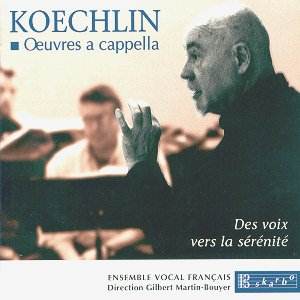CHARLES KOECHLIN (1867-1950) - Des voix vers
la sérénité
A Cappella Works
Choeurs réligieux a cappella: Kyrie; Agnus Dei;
Alleluia (1935)
Motets de style archaïque (1949) - fifteen motets
 Ensemble Vocal
Francais/Gilbert Martin-Bouyer
Ensemble Vocal
Francais/Gilbert Martin-Bouyer
Amélie Berson (flute); Nicolas Carpentier (oboe); Christophe Bonifacino
(clarinet); Alexandre Salles (bassoon).
rec Chapelle de l'Hôpital d'Ivry, Val de Marne, France, 1997, DDD
 SKARBO SK 2972
[60.31]
SKARBO SK 2972
[60.31]
AmazonUS

'We write to tell and express what we like, with no other idea than saying
it as well as possible with the most complete Faith ... Faith in the future
of what is beautiful, faith in all divine elements of Nature and Mankind
...' (Charles Koechlin)
In the Op. 150 work (or at least in the three extracts we have here)
Koechlin reaches heavenwards and pours a wondering emotional charge into
a framework that leans into the examples of Allegri's Miserere and
of Tallis's Spem in Alium in its rich complexity.
The gloriously varied Motets are his last work and in fact were not
quite finished. Here No. 7 has been left incomplete but Pierre Renaudin added
the instrumental parts to the last piece. The Motets show the composer with
powers still at high tilt.
The works are best outlined in note-form. No. 1. Voix d'hommes:
male voices trace, with increasing density, a theme familiar from the finale
of Saint-Saëns' Third Symphony; No. 2 Voix d'Enfants:
The voices of children - a dancingly Holstian movement - light as apple blossom;
No. 3 La Crypte: mystic bass-inclined music: cocooned and honeyed
singing but, like the other tracks, with plenty of melodic interest; No.
4 Motet en Canon - light as light on the aural receptors with
a dancing fugal tenderness at 1.10; No. 5, choral dans la
crypte; a de profundis atmosphere dark and deep as anything
to be found in the Rachmaninov Vespers but rising on the lightly buoyant
sopranos into morning and renewal. No. 6 Choral en imitations:
playful, pointed and accented staccato singing with the vocal ensemble joined
by a quartet of wind instruments. No. 7 Chanson en canon. a
hearty British monk-like jollity but ending on a stratospheric stabbed high
note for the sopranos. No. 8 Exposition de fugue et stretto.
Carrying the legacy of plainchant and monastery chapels but with blissful
abandon lighting up the women's voices rising to a high libertine note all
underpinned by sustained bass notes from the men. No. 9.
Chanson: scored skippingly for flute and clarinet alone. No.
10: a restrained Eleison marked andante; No. 11
Monodies for clarinet and flute again. A luminous legato whose
perfection is only moderated by the sound of key action from the clarinet.
The flute is more liquid still. A late afternoon nostalgia. No. 12 Pour
un conduit: back to monastic contemplation - gradually introducing
the voices of all of the choir. No. 13. Exposition et Strette.
An accent-emphasised 'bounce' in the voices like a grave galliard or a march
with a skip in its step. Linked with the Choral en imitations. No.
14. Assez lent. Reticent meditative ecstatics. No. 15.
Mystique et lumineux. Straining the women's voices which winsome
and harmless fallibility is also noticeable in the earlier pieces in the
sequence. But let me emphasise this is an interpretation sans pareil.
Translation of notes into English is bumpy but understandable enough.
Rob Barnett

